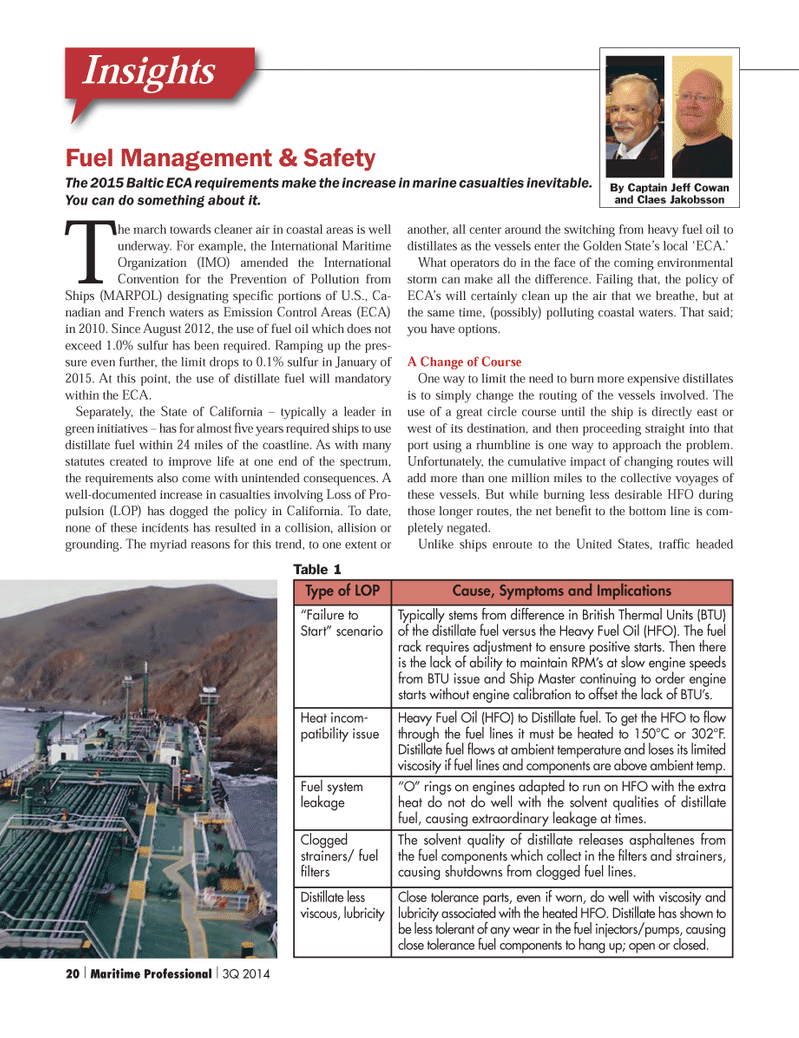
Page 20: of Maritime Logistics Professional Magazine (Q3 2014)
Power & Fuel Management
Read this page in Pdf, Flash or Html5 edition of Q3 2014 Maritime Logistics Professional Magazine
The march towards cleaner air in coastal areas is well underway. For example, the International Maritime Organization (IMO) amended the International Convention for the Prevention of Pollution from Ships (MARPOL) designating speciÞ c portions of U.S., Ca- nadian and French waters as Emission Control Areas (ECA) in 2010. Since August 2012, the use of fuel oil which does not exceed 1.0% sulfur has been required. Ramping up the pres- sure even further, the limit drops to 0.1% sulfur in January of 2015. At this point, the use of distillate fuel will mandatory within the ECA.Separately, the State of California Ð typically a leader in green initiatives Ð has for almost Þ ve years required ships to use distillate fuel within 24 miles of the coastline. As with many statutes created to improve life at one end of the spectrum, the requirements also come with unintended consequences. A well-documented increase in casualties involving Loss of Pro- pulsion (LOP) has dogged the policy in California. To date, none of these incidents has resulted in a collision, allision or grounding. The myriad reasons for this trend, to one extent or another, all center around the switching from heavy fuel oil to distillates as the vessels enter the Golden StateÕs local ÔECA.Õ What operators do in the face of the coming environmental storm can make all the difference. Failing that, the policy of ECAÕs will certainly clean up the air that we breathe, but at the same time, (possibly) polluting coastal waters. That said; you have options. A Change of CourseOne way to limit the need to burn more expensive distillates is to simply change the routing of the vessels involved. The use of a great circle course until the ship is directly east or west of its destination, and then proceeding straight into that port using a rhumbline is one way to approach the problem. Unfortunately, the cumulative impact of changing routes will add more than one million miles to the collective voyages of these vessels. But while burning less desirable HFO during those longer routes, the net beneÞ t to the bottom line is com-pletely negated. Unlike ships enroute to the United States, trafÞ c headed Fuel Management & Safety The 2015 Baltic ECA requirements make the increase in marine casualties inevitable. You can do something about it. InsightsBy Captain Jeff Cowan and Claes JakobssonType of LOPCause, Symptoms and Implications ?Failure to Start? scenario Typically stems from difference in British Thermal Units (BTU) of the distillate fuel versus the Heavy Fuel Oil (HFO). The fuel rack requires adjustment to ensure positive starts. Then there is the lack of ability to maintain RPM?s at slow engine speeds from BTU issue and Ship Master continuing to order engine starts without engine calibration to offset the lack of BTU?s. Heat incom-patibility issueHeavy Fuel Oil (HFO) to Distillate fuel. To get the HFO to ow through the fuel lines it must be heated to 150°C or 302°F. Distillate fuel ows at ambient temperature and loses its limited viscosity if fuel lines and components are above ambient temp.Fuel system leakage?O? rings on engines adapted to run on HFO with the extra heat do not do well with the solvent qualities of distillate fuel, causing extraordinary leakage at times. Clogged strainers/ fuel ltersThe solvent quality of distillate releases asphaltenes from the fuel components which collect in the lters and strainers, causing shutdowns from clogged fuel lines.Distillate less viscous, lubricityClose tolerance parts, even if worn, do well with viscosity and lubricity associated with the heated HFO. Distillate has shown to be less tolerant of any wear in the fuel injectors/pumps, causing close tolerance fuel components to hang up; open or closed.Table 1 20 | Maritime Professional | 3Q 201418-33 Q3 MP2014.indd 2018-33 Q3 MP2014.indd 208/15/2014 9:50:42 AM8/15/2014 9:50:42 AM

 19
19

 21
21
